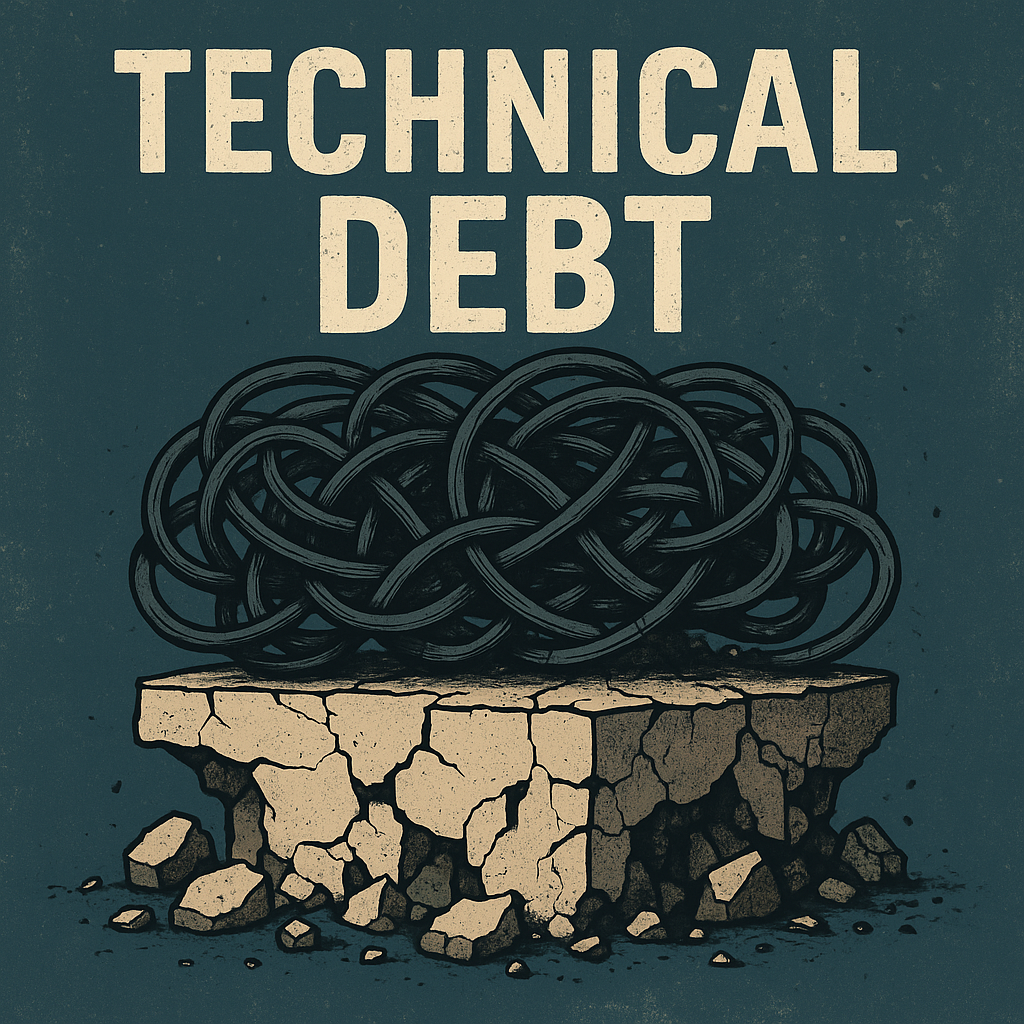Technical Debt Is Coming for Your Business—And AI Is Making It Worse
TLDR
Companies are spending 10–20% of their tech budget servicing technical debt.But there's a bigger cost. Opportunity loss. To make matters worse, we’re entering an age where clean, connected, and modern systems aren’t nice to have—they’re table stakes. If your company is building on a shaky foundation, it's time to reset.
Technical debt has evolved from a hidden IT problem into a board-level strategic concern. For medium and large enterprises in sectors like manufacturing, heavy machinery, and rental services, the cost of inaction is high – measured in millions of dollars, security risks, lost agility, and missed opportunities. Conversely, the payoff for systematically reducing technical debt is substantial: lower costs, higher reliability, faster innovation, and a foundation ready for technologies like AI and IoT at scale.
Now, with AI accelerating the pace of innovation and data at the core of every decision, technical debt isn’t just a nuisance—it’s a threat to your future.
More than 20% of an IT budget for new projects is diverted to resolving issues related to tech debt.
McKinsey
What Is Technical Debt?
Technical debt is the cost of shortcuts taken in software, infrastructure, or data architecture that eventually need to be reworked. It’s the code you didn’t refactor, the data you didn’t clean, the system you built for “just for now” that’s still running five years later.
There are many flavors:
- Code Debt: Spaghetti code, lack of documentation, outdated frameworks.
- Data Debt: Inconsistent naming, duplicate records, missing lineage, poor data governance.
- Infrastructure Debt: Legacy servers, patchwork cloud setups, siloed systems.
- Integration Debt: APIs that don’t scale, poorly designed services that prevent automating processes across systems.
Each comes with a quiet price—until suddenly, it’s loud.
The Real Cost of Technical Debt
According to McKinsey, companies spend 10–20% of their tech budget servicing technical debt.(mckinsey.com)In large enterprises, that can mean millions of dollars each year just keeping bad systems alive. But the bigger cost? Opportunity loss.
- Your engineers can’t innovate because they’re firefighting.
- Your AI models are biased or broken due to bad data.
- Your customers feel the lag—literally and figuratively.
Tech debt slows you down when you need to move fast.
In the AI Era, That Debt Gets Exponential
AI doesn’t just build on top of your systems—it amplifies what’s underneath. If your foundation is shaky, your AI outcomes will be too. Garbage in, garbage out, but now at the speed of machine learning.
- Bad data? Your predictions will fail and offer incorrect guidance.
- Siloed systems? Your LLM integrations fall apart.
- Poor infrastructure? Your AI operations spiral into chaos.
We’re entering an age where clean, connected, and modern systems aren’t nice to have—they’re table stakes.

The Cost to Move (and Why Now Is the Time)
Yes, paying down tech debt has a cost. But waiting costs more. Every month you wait, systems get more entangled, your team gets more burned out, and your competitive edge dulls.
Investing in cleanup now prevents:
- Costly AI rework later
- Regulatory risk (especially with data)
- Missed market opportunities
The earlier you fix, the cheaper it is. And the right partner can help you surgically address what matters most — without rebuilding everything.
What You Need Is a Technical Reset
At Emory Solutions, we help companies reclaim their agility by:
- Auditing your systems to identify the worst debt pockets
- Refactoring your data pipelines to support AI-readiness
- Modernizing infrastructure for scalable, secure operations
- Creating connective tissue between the tools you already use
You don’t need to throw everything out. You need to realign your foundation with where the world is going.
Uplift Opportunity
Various studies draw a line from tech debt reduction to business performance metrics. For instance, one report found organizations that aggressively modernize see 14% higher revenue on average, attributable to increased agility and innovation (phoenixstrategy.group). Another survey (AlixPartners Digital Disruption 2024) observed that among companies confident in their legacy management (i.e. low tech debt), 59% were forecasting growth, whereas virtually none of the companies with highly problematic legacy systems expected growth (alixpartners.com). In contrast, high tech debt tends to cause a “slow and steady erosion” of profitability – a boiling frog scenario where EBITDA margins shrink under the weight of inefficiency (alixpartners.com). Thus, the ROI of paying down tech debt is not only cost avoidance but also improved growth trajectory and competitiveness. It positions the enterprise to fully leverage digital technologies (cloud, AI, analytics) that drive future success.
Ready to Get Ahead?
Technical debt is inevitable. But how you manage it determines whether it’s a speed bump—or a cliff.
If your company is building on a shaky foundation, now is the time to reset. Let’s talk.
Schedule a virtual coffee chat
To learn more about your opportunities, competitiveness, and how you can take advantage of your opportunities from our point of view.